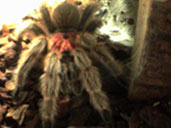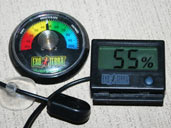Chilean Rose Tarantula Care Sheet
Common names: Chilean Rose Scientific Name: Grammostola rosea DescriptionDescription: Chilean Rose are predominantly dark brown but have a covering of reddy pink hairs over their entire body. The pink colouring to these hairs is where the name rose comes from. They are a medium sized terrestrial spider. Size: Chilean Rose Tarantulas can achieve a leg span of up to about 5 or 6 inches. Life span: Chilean Rose Tarantulas have not been in the hobby long enough to accurately say how long they live, an educated guess would be 20+ years. Males live significantly shorter lives than females, probably in the region of 3 - 7 years. Origin: Chilean Rose Tarantulas are native to Northern Chile, although they can also be found in Bolivia and Argentina. Habitat: An enclosure of approximately 3 times the leg span in length, 2 times the leg span in width and height is required to adequately house this particular spider. They are a terrestrial species and require deeper substrate rather than height to climb. Do make sure that your lid can be securely attached as they will escape given the chance. TemperamentChilean Rose Tarantulas are a very docile, calm and mild mannered spider and are therefore a highly recommended first spider. If upset they are likely to rear up with their front legs or spray urticating hairs from their abdomen. Keep your face well away from your Chilean Rose, as urticating hairs to the face would not be at all pleasant. They are unlikely to bite although do have the ability to if pushed. Your terrarium/vivarium should containAll that is really needed for this species of spider is a hide and a water bowl. The water bowl needs to be buried so just the rim is above the substrate. They require hides on ground level (buried slightly) and you can use anything at all as a hide really, I would suggest cork bark, coconut halves and plant pots as good and inexpensive hide solutions. Any decoration other than this is up to you, although plastic plants do look nice. Do not use sponges in your water bowl as they are not needed and are really just a breeding ground for bacteria and other nasty things. SubstrateChilean Rose Tarantulas need quite a dry, but not overly sandy substrate so a 70 - 30 mix of peat moss (potting soil works just as well) and sand is ideal. Coco fibre is also available and can replace the potting soil or peat moss, it does make a good substrate although I personally never use it and always go for peat moss. The substrates depth should be half of the height of the enclosure to allow for burrowing (although they are unlikely to make burrows in captivity) and to make sure that the spider is not hurt if it does decide to climb. With all substrates that you use, always make sure that it is additive and chemical free. Humidity A digital hygrometer is highly recommended to allow for monitoring of the humidity. HeatA temperature of between 24-27°C (75 -80°F) should be maintained at all times. This temperature can be achieved by attaching a heat mat to the outside back wall of your Chilean Rose’s enclosure. A thermostat is very highly recommended and since a heat mat should provide sufficient heat to keep your Chilean Rose happy, a basic mat stat, like the Microclimate Ministat 100 or the Habistat Mat Stat, should be appropriate. These thermostats are available from reptile shops and online, are relatively cheap, and will ensure the heat source is regulated at a safe level. A thermometer is also recommended. LightingArtificial lighting should be avoided at all costs with this particular species, they do not need or want to be in a well lit enclosure. That being said, a room that is light in the day and dark at night is recommended as long as the spider is not in direct sunlight. General CareFeedingA live invertebrate prey item of approximately half of the spiders body length is required. You can choose to feed crickets, locusts, mealworms, or even cockroaches. Wingless fruit flies are also a good option for feeding spiderlings. Approximately 4 or 5 appropriately sized food items should be offered per week, they can be offered all in one go but if they have not been consumed within 24 hours they should be removed and you should try feeding again in a weeks time. HandlingHandling of any tarantula is not without risks, they all have the potential to bite and are all venomous. The strength of the venom is not enough to kill you but is certainly not pleasant. Your Chilean Rose does not need or want to interact with you and will gladly spend all of its time just going about its business undisturbed. That being said, you can, if you wish, handle your spider. Chilean Rose Tarantulas are usually very tolerant of handling but you ignore the warning signs at your own peril. For starters, if you handle your Chilean Rose and are scared or nervous it is very likely to end up with injury to either you or your spider... or both of you! To handle your spider and to minimise the risks the best way is to have a paint brush or another soft item available to gently push your Chilean Rose. Now, place your hand palm up so that your spider’s head is facing you, if it shows any threatening signs, such as rearing up with its front legs... STOP, the spider clearly does not want to to be handled. Next, using the paint brush you need to gently prod the abdomen or rear feet of your spider, you will either see the spider walk forwards, rear up or spray urticating hairs. If your Chilean Rose has now walked onto your hand you should lift your hand slowly out of the enclosure and allow the spider to walk from hand to hand. Keep your movements slow and try not to breathe on the spider, this should help to keep your Chilean Rose calm and not spook it. Until you grow in confidence it would be advisable to keep your hands close to a table or bed so that if you drop it you will lessen any possible damage caused. This website will not take any responsibility for injury caused to either you or your Chilean Rose, you handle it at your own risk. MoltingTo grow, your spider grows a new skin below its current exoskeleton, when the spider has grown sufficiently it will need to break out of its old exoskeleton. This is called molting. At this time your spider will show less interest in its food and will appear to be being very lazy. You will also probably see your spider laying on its back, it is VERY important that you do not touch your Chilean Rose when it is laying like this, you also need to remove all uneaten prey items from the enclosure as gently and quietly as you possibly can. The spider will eventually split open its old exoskeleton and wriggle its way out, the spider’s nice new exoskeleton will still be very soft and you will more than likely see it just sitting still as it hardens. Only remove the shed exoskeleton when your Chilean Rose is again actively walking around its enclosure or has returned to its hide. You should also not offer any food items to your Chilean Rose for a week as your spider’s skin and fangs will still be rather soft so it will not be able to eat. SexingSexing of a Chilean Rose is really quite a simple process if you have access to a previously shed skin. If you do have access to a shed skin you need to look inside on the abdomen just about where it meets the carapace, if you have a female spider you will see a prominent structure known as the spermathecae which is basically a sperm receptacle. A male spider will clearly not have this present. The spermathecae, or lack of it, is clearly visible to the naked eye if the spider is large enough, although a microscope or strong magnifying glass will be needed for a spiderling. An easy way of identifying a male tarantula that is living is to again look on the ventral (belly) side of the spider, on the abdomen just about where it meets the carapace there is what is known as the epigastric plates. Next to this, going in the direction of the spinnerets is what is known as the epigastric furrow. On the central anterior side of this furrow you will see an almost arch shaped patch of dark, short, densely packed setae (bristles), these are only found on male spiders and are actually very small spinnerets that are believed to be used when the male makes a sperm web. Mature male Chilean Rose Tarantulas also tend to have longer legs and appear to be more fuzzy than the females. BreedingFemale spiders benefit from a cooling period of a few months prior to mating. When your mature male makes a sperm web he is ready to be introduced to the female. He should be placed inside the female’s enclosure, at which time he will slowly walk up to the female’s hide vibrating his legs and tapping his feet into the ground to lure the female out. When she is out far enough the male will usually lunge onto her and push her into an almost upright position so that he has sufficient access to the female’s epigyne. At this time the male will insert one or the other of his pedipalps into the female’s epigyne to inject his sperm. When the male disengages from the female he should immediately be removed from the female’s enclosure. If the female has been successfully mated she will produce an egg sac over the coming weeks. The egg sacs can contain over 250 babies. Any more Questions?This care sheet is a simple step-by-step guide to successful Tarantula keeping, but if you have anymore questions or need more specific information about the care of your Chilean Rose spider, please enter our forum. It is a useful resource where you can ask other members to share good practice and also talk about your experiences of being a Chilean Rose keeper.
|
|


 High humidity is not needed for this particular species of spider, they will be perfectly happy with a humidity of around 65% -75%, although at no time should the humidity be allowed to drop below about 55%. Just having a water bowl available at all times will go a long way to providing the needed humidity, a very light misting of the substrate (or sphagnum moss if you would like to provide it) every so often is all that is really needed other than that. Do make sure that the substrate is only very slightly damp, not saturated.
High humidity is not needed for this particular species of spider, they will be perfectly happy with a humidity of around 65% -75%, although at no time should the humidity be allowed to drop below about 55%. Just having a water bowl available at all times will go a long way to providing the needed humidity, a very light misting of the substrate (or sphagnum moss if you would like to provide it) every so often is all that is really needed other than that. Do make sure that the substrate is only very slightly damp, not saturated. 